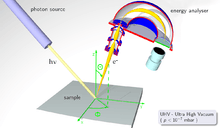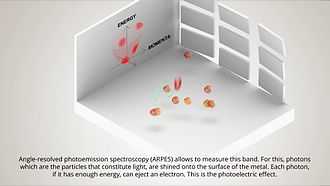Angle-resolved photoemission spectroscopy
| Condensed matter experiments |
|---|
 |
| ARPES |
| Neutron scattering |
| X-ray spectroscopy |
| Quantum oscillations |
| Scanning tunneling microscopy |


Angle-resolved photoemission spectroscopy (ARPES), also known as ARUPS (angle-resolved ultraviolet photoemission spectroscopy), is a direct experimental technique to observe the distribution of the electrons (more precisely, the density of single-particle electronic excitations) in the reciprocal space of solids. ARPES is one of the most direct methods of studying the electronic structure of the surface of solids.
ARPES gives information on the direction, speed and scattering process of valence electrons in the sample being studied (usually a solid). This means that information can be gained on both the energy and momentum of an electron, resulting in detailed information on band dispersion and Fermi surface. This technique is a refinement of ordinary photoemission spectroscopy.
Theory
From conservation of energy, we have
where E is the binding energy of the electron. Photon energy is often neglected because of its smallness compared with electron energy.
In the typical case, where the surface of the sample is smooth, translational symmetry requires that the component of electron momentum in the plane of the sample be conserved:
where
 kinetic energy of the outgoing electron — measured.
kinetic energy of the outgoing electron — measured. incoming photon energy — measured.
incoming photon energy — measured. electron work function (energy required to remove electron from sample to vacuum)
electron work function (energy required to remove electron from sample to vacuum) momentum of the outgoing electron, measured by angle
momentum of the outgoing electron, measured by angle initial momentum of the electron
initial momentum of the electron
However, the normal component of electron momentum  might not be conserved. The typical way of dealing with this is to assume that the final in-crystal states are free-electron-like, in which case one has
might not be conserved. The typical way of dealing with this is to assume that the final in-crystal states are free-electron-like, in which case one has
in which  denotes the band depth from vacuum, including electron work function
denotes the band depth from vacuum, including electron work function  ;
;  can be determined by examining only the electrons emitted perpendicular to the surface, measuring their kinetic energy as a function of incident photon energy.
can be determined by examining only the electrons emitted perpendicular to the surface, measuring their kinetic energy as a function of incident photon energy.
The equations for energy and momentum can be solved to determine the dispersion relation between the binding energy,  , and the wave vector,
, and the wave vector,  , of the electron.
, of the electron.
See also
External links
- Andrea Damascelli, "Probing the Electronic Structure of Complex Systems by ARPES", Physica Scripta T109, 61-74 (2004)
- Angle-resolved photoemission spectroscopy of the cuprate superconductors (Review Article) (2002)
- ARPES experiment in fermiology of quasi-2D metals (Review Article) (2014)


